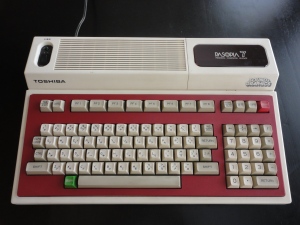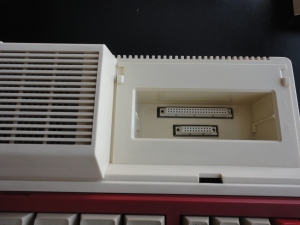Toshiba was perhaps the biggest laggard amongst all large Japanese companies as far as home computers go (along with Hitachi). They did come up with a model fairly early (T-200 in 1980) and follow that with the Pasopia line (from 1981 to 1983). But the Pasopia line did not get a lot of attention and it was dropped in favor of the MSX models (the HX line) which ultimately failed as well.
The machine I got is the 1983 Pasopia 7 which is the last true Pasopia (one of the HX machines would be named Pasopia IQ but that made very little sense since that was a machine very close to the HX line and not related at all to all previous Pasopia models). This is a pretty interesting machine and it seems very capable against the competition of its time. The keyboard is very responsive, the case is sturdy and the built-in Basic (T-Basic 7) has some cool features. This computer supports 27(!) colors which as far as I know was the highest for any 8 bit machine and it would only be beat by the MSX 2 machines, 3 years later.
One quirky thing about this machine was the capability of changing the overlay panel around the keyboard. My computer only came with one panel (red) but I believe it originally came with 3 different colors. This computer also has a FM-7 like connectors that allow different boards/cartridges to be connected. These are very rare to come around so I am not sure of the details.
The biggest issue for this computer is to find software. So far I have had no luck in the Japanese auctions (only saw 2 games so far, both very expensive) so I need to start looking into alternatives. I am not even sure if there are game dumps out there. Even if there are, I need to find a good emulator and try to use the ‘connect my cassette port to my PC speaker’ trick and see if it works.
Machine Specs:
| NAME | PASOPIA 7 |
| MANUFACTURER | Toshiba |
| TYPE | Home Computer |
| ORIGIN | Japan |
| YEAR | 1983 |
| BUILT IN LANGUAGE | T-Basic 7 |
| KEYBOARD | Full-stroke keyboard with separated numeric keypad |
| CPU | Zilog Z80-A |
| SPEED | 4 MHz |
| RAM | 64 KB |
| VRAM | 56 KB |
| ROM | 48 kb (32 kb Basic + 16 kb Bios) |
| TEXT MODES | 40 x 25 / 80 x 25 |
| GRAPHIC MODES | 320 x 200 / 640 x 200 with 27 colours |
| I/O PORTS | RS232, disk controller, Z-80 card (to run CPM), expansion port, printer, audio cassette, RGB, Mono Composite |
| POWER SUPPLY | Built-in power supply unit |
| PERIPHERALS | disk-drive, Chinese characters ROM, RS232 Interface, memory upgrade, printer |

